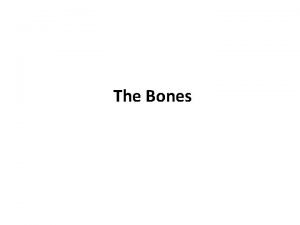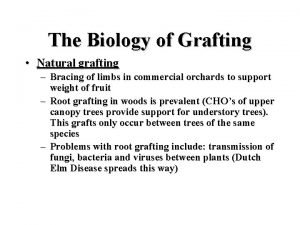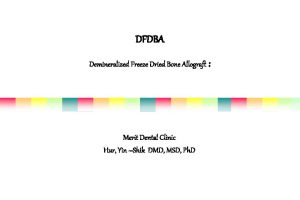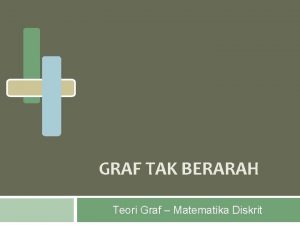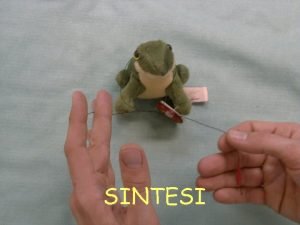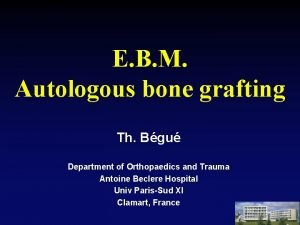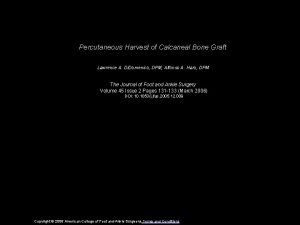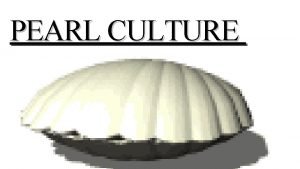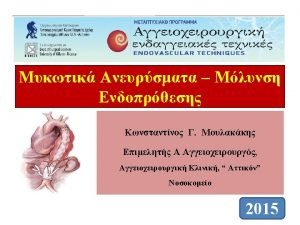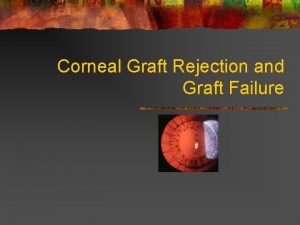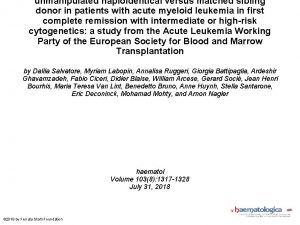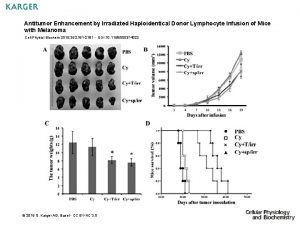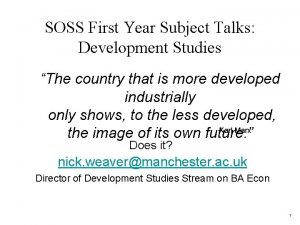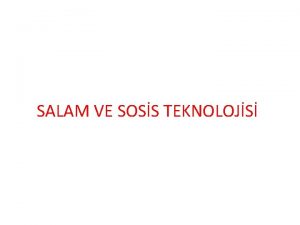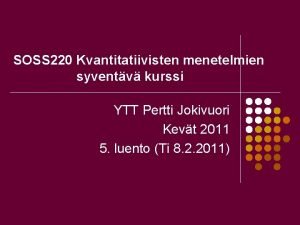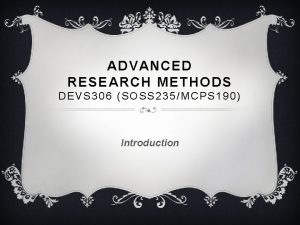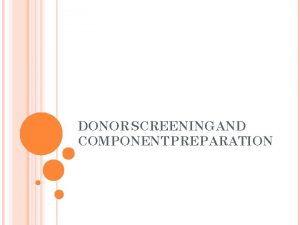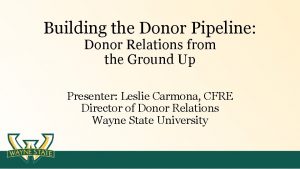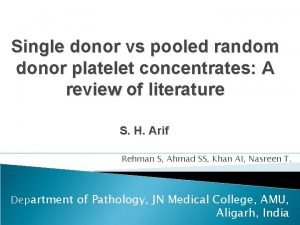SOSS Committee Optimal Donor and Graft Sources Haploidentical












- Slides: 12

SOSS Committee Optimal Donor and Graft Sources: Haploidentical vs Unrelated Donor Transplantation with Post-transplant Cyclophosphamide (PTCy) Karen Ballen, MD University of Virginia

Conflict of Interest Disclosure • No Conflicts to Disclose 2

Committee Members Support provided by grants #U 10 HL 069294 and #U 24 HL 138660 to the Blood and Marrow Transplant Clinical Trials Network from the National Heart, Lung, and Blood Institute and the National Cancer Institute. The content is solely the responsibility of the authors and does not necessarily represent the official views of the National Institutes of Health. 3

Proposed Study Concepts • Strategy 1: Haploidentical vs Unrelated Donor Transplantation with Post-transplant Cyclophosphamide (PTCy) • Strategy 2: GVHD Prophylaxis for Mismatched Unrelated Donor Transplantation. • Strategy 3. Reducing Toxicity of Umbilical Cord Blood Transplantation in Leukodystrophies 4

Haploidentical vs Unrelated Donor Transplantation with Post-transplant Cyclophosphamide Hypothesis: Unrelated Donors (UD, intervention) provide better two year overall survival than Haploidentical Donors (Haplo, control). Importance to Field: No Randomized Published Data to Date to Answer this Question Crucial, Everyday Question for Many Transplant Centers Use of mismatched unrelated donors (MMUD) opens eligibility to patients of diverse ethnic and racial backgrounds 5

Background & Significance • Control of alloreactivity by Post Transplant Cytoxan (PTCy) enabled safe use of Haplo donors • Retrospective comparisons show similar survival with haplo/PTCy and MUD with traditional calcineurin inhibitor based GVHD prophylaxis • PTCy may also improve outcomes following matched and mismatched UD transplants • Selection of MUD and MMUD may allow optimization of other donor characteristics, including donor age. 6

Trial Design • Phase III trial randomizes patients to best available UD (MUD or MMUD) vs best haplo PBSC graft as soon as it is known that an HLA-matched relative is not available – analysis by Intention to Treat • Myeloablative and reduced intensity strata • GVHD prophylaxis PTCy/mycophenolate mofetil/CNI (+others? ) • Patients 18 -75 with acute leukemia in CR 1 or myelodysplasia with < 5% blasts • Primary endpoint: two-year survival • Secondary endpoints: time to transplant, TRM, relapse, QOL, CRS, cost • Sample size estimates assume 55% two-year survival with Haplo, based on CIBMTR data, and a two-sided 0. 05 significance level • 824 (1050) patients to detect absolute 10% improvement with 80% (90%) power 7

Feasibility & Logistics • CIBMTR data indicate >2000 patients eligible for this study are transplanted in the US annually • Anticipated accrual time is 2 -3 years. • Post transplant maintenance would be permitted • Other details of supportive care, donor selection guidelines to be developed by protocol team 8

External Review • “No matter what the answer, it will help us in deciding which to do when there is a choice. ” (Forman-2) • What happens to patients who do not have an available UD – physician choice but analyzed by ITT • Haploidentical donors easier to resource quickly – inherent part of the strategy to be tested; time to transplant will also be measured • Donor age may be different in the groups: inherent part of the strategy to be tested; donor age will be captured • Are there data to support the 2 -year 55% survival rate? 55% survival rate determined from CIBMTR data on potentially eligible patients receiving haplo • What is the current 2 -year survival of UD with PTCy? Two-year survival is 65% for patients transplanted in 2015 -2020, according to CIBMTR data 9

Online Feedback-Median Score of 2 How does this trial differ/add to ongoing trials in Europe? NCT 04067180 – Haplo vs matched unrelated for AML-prefer BM but accept PBSC – BM preferred over PBSC – MUD GVHD prophylaxis: Center discretion – Need to identify matched unrelated donors - would limit racial/ethnic diversity, exclude high risk patients, many diverse patients and early relapsers – 200 patients - too small for definitive results NCT 03655145 – Haplo vs MUD using MAC only – MUD PBSC / Haplo BM – Need to identify matched unrelated donors - would exclude many diverse patients and early relapsers – 334 patients - too small for definitive answer NCT 03275636 – Haplo vs MMUD (HAMLET) – Different question – 266 patients 10

Issues Raised That Would Need to be Clarified by the Protocol Team at Time of Protocol Development • • • Use of Bone Marrow in addition to PBSC Degree of mismatch allowed for UD Conditioning regimens to be allowed Inclusion of drugs beside MMF/CNI with PTCy Other Secondary Objectives: impact of molecular/cytogenetic risk factors, KIR, specific mismatches and cryopreservation • Inclusion of pediatric patients if COG study not moving forward • Inclusion of CR 2 patients 11

Q&A Session 12
 Print and web sources
Print and web sources Can you do bone graft and implant at the same time
Can you do bone graft and implant at the same time Water resources importance
Water resources importance Grafting biology
Grafting biology Caldwell technique vestibuloplasty
Caldwell technique vestibuloplasty Dfdba bone graft
Dfdba bone graft Dr neil dsouza
Dr neil dsouza Contoh graf semu
Contoh graf semu 1 prolene suture
1 prolene suture Autologous bone graft definition
Autologous bone graft definition Calcaneal bone graft
Calcaneal bone graft Pearl culture definition
Pearl culture definition Pathophysiology of aortic aneurysm ppt
Pathophysiology of aortic aneurysm ppt

